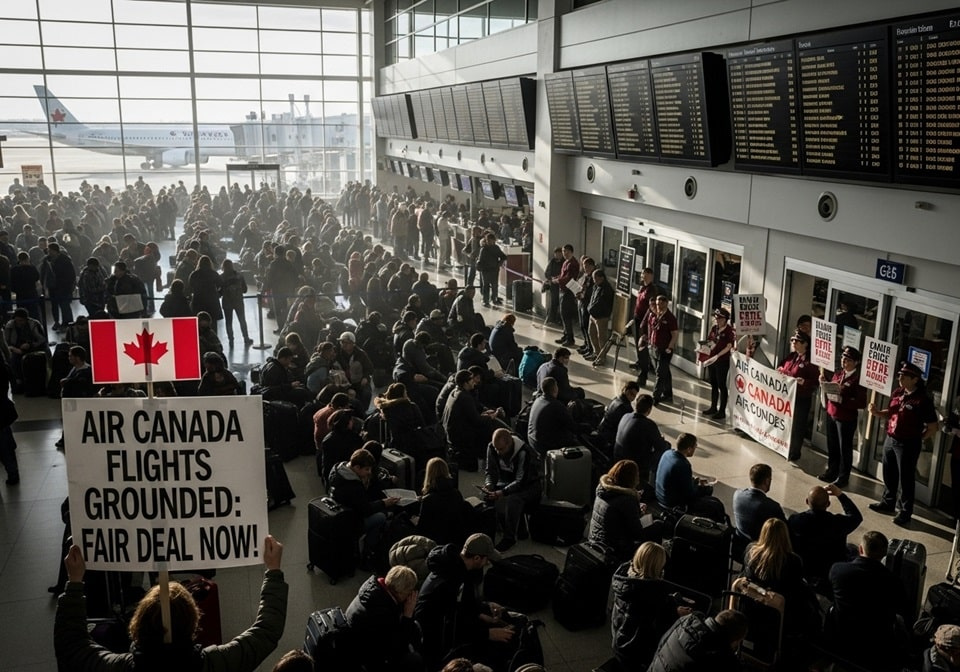
The labor dispute escalated on Saturday morning when the Canadian Union of Public Employees (CUPE) announced that its members had officially gone on strike. This action, a direct response to a breakdown in months of contract negotiations, came after flight attendants issued a 72-hour strike notice. Air Canada, in turn, began a gradual shutdown of its operations, leading to a complete grounding of its main fleet and its subsidiary, Air Canada Rouge.
At the heart of the standoff were two primary points of contention. First, the union was seeking significant wage increases to keep pace with the high rate of inflation that has eroded the real value of their wages over their previous ten-year contract. Second, and perhaps more symbolically important, was the demand for compensation for unpaid ground duties. Flight attendants argued that they were not being paid for crucial work performed before and after flights, such as assisting passengers with boarding and deplaning.
Air Canada had tabled a comprehensive offer that included what it called a “38% increase in total compensation” over four years, which also included a provision for some ground pay. However, CUPE swiftly rejected this proposal. The union’s leadership argued that the offer was misleading and that the actual wage increase was insufficient to address the rising cost of living. They maintained that the airline was not seriously bargaining and was instead hoping for government intervention to impose a deal.
With airports in major Canadian cities—including Toronto, Montreal, and Vancouver—descending into a state of chaos, the pressure on the federal government to act became immense. Airlines had already canceled hundreds of flights, affecting approximately 130,000 customers per day. The disruption had a cascading effect on the national economy, impacting both passenger travel and vital cargo shipments. The business community, including the Canadian Chamber of Commerce, publicly urged the government to use its authority to end the strike.
In a significant development, Jobs Minister Patty Hajdu announced the government’s decision to order a return to work and impose binding arbitration on both parties. This legal directive, issued through the Canada Industrial Relations Board (CIRB), is a powerful tool under the Canada Labour Code designed to protect the national economy from crippling labor disputes. The government’s position was that the economic impact of the strike was “simply too great” to allow it to continue.
While Air Canada immediately welcomed the move, seeing it as a necessary step to restore stability, CUPE’s response was one of staunch defiance. Union president Wesley Lesosky called the government’s order “unconstitutional” and accused the federal administration of siding with the airline. He stated that the members would not comply with the back-to-work order. Despite the legal directive, the union has continued to encourage its members to remain on the picket lines, creating a tense standoff between the government, the airline, and the union.
The short-term outlook for travelers remains challenging. Even with the government’s order, Air Canada has warned that it will take several days to a full week for operations to return to normal. The airline has stated it will begin a “gradual ramp-up” of its flight schedule, but some cancellations are still expected over the coming week.
For affected passengers, Air Canada is offering full refunds for flights that were canceled and is also providing a flexible rebooking policy. However, the airline has strongly cautioned that finding alternative flights on other carriers is incredibly difficult due to the high volume of summer travel. The advice to travelers remains the same: do not go to the airport unless you have a confirmed booking and consistently check your flight status online.
The implications of this strike extend beyond the immediate travel disruption. It has reignited the debate about the balance of power in labor negotiations and the government’s role in intervening in private-sector disputes. CUPE has expressed its belief that Air Canada was leveraging the likelihood of government intervention to avoid genuine bargaining, a sentiment that resonates with a broader frustration among some labor groups. This situation serves as a stark reminder of the fragile nature of critical supply chains and the profound impact that a single labor dispute can have on an entire nation’s economy and its citizens.
Historically, the Canadian government has often intervened in major transportation strikes, a practice that highlights the strategic importance of these industries. Past interventions in rail and port strikes have set a precedent, which Air Canada and other businesses likely factored into their negotiation strategy. The union, however, views these interventions as an unfair erosion of their right to collective bargaining and a way for companies to avoid making concessions.
As the situation unfolds, all eyes are on the next steps. The CIRB is expected to finalize the terms of the binding arbitration, which will legally mandate a new contract. However, if the union continues to defy the back-to-work order, it could face significant fines and other legal consequences. The outcome of this dispute will not only determine the future of Air Canada’s flight attendants’ contract but could also shape the landscape of labor relations in Canada for years to come.
The effects of the strike are also being felt by other airlines and travel companies. Many airlines are now dealing with an influx of rebooked passengers, straining their own resources. The disruption is a reminder to passengers of the importance of travel insurance and flexible booking options, especially during high-demand seasons. The ripple effect has also impacted international travelers flying to or from Canada, as many connecting flights have been disrupted.
The full economic impact of the strike is still being calculated. Beyond the immediate losses for Air Canada and its employees, the disruption affects tourism, business travel, and cargo transport, all of which are vital components of the Canadian economy. The swift government action, while controversial to some, underscores a clear priority to protect these economic interests at all costs.
In conclusion, the 2025 Air Canada flight attendants’ strike has become a high-stakes standoff between a major corporation, a powerful union, and the federal government. While a temporary resolution has been imposed, the underlying issues of fair pay and the rights of workers remain unresolved. The ongoing defiance from the union suggests that even with a legal order, the journey back to normalcy for Air Canada and its passengers may be long and complicated.





